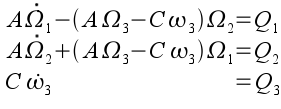A gyroscope in the following set up is used to demonstrate precession.

Weights were hung from the point marked 1, and the rate of precession recorded, this was compared to the theoretical value for precession.
Videos of precession
Measured precession rate
| Mass (Kg) | Precession rate (rad/s) |
| 1.22 | 0.24 |
| 2.22 | 0.46 |
| 3.22 | 0.65 |
Theoretical calculation of precession rate
It has been shown that Euler's equations of motion can be written as:
Where the applied couple is
given by

From the above diagram it can be seen that the applied couple just acts about the j axis (ignoring friction) and so Q=Q2j.
For steady state motion the second of the gyroscope equations can be written as follows.

A fast spinning rotor was used, and so it was considered a fair assumption to assume fast spin, this reduces the above equation to the following (where Euler's angles have been substituted in).

In this case = 90, and so sin
= 90, and so sin =1
=1
The applied couple is also given by mgd. Using this combined with the above equation gives the following expression for the theoretical value of precession rate of the gyroscope in the top figure (assumes steady state and fast spin).

For the gyroscope in question


From the above diagram it can be seen that the applied couple just acts about the j axis (ignoring friction) and so Q=Q2j.
For steady state motion the second of the gyroscope equations can be written as follows.

A fast spinning rotor was used, and so it was considered a fair assumption to assume fast spin, this reduces the above equation to the following (where Euler's angles have been substituted in).

In this case
 = 90, and so sin
= 90, and so sin =1
=1The applied couple is also given by mgd. Using this combined with the above equation gives the following expression for the theoretical value of precession rate of the gyroscope in the top figure (assumes steady state and fast spin).

For the gyroscope in question

Using the above theoretical values of precession rate are calculated, these are compared to actual values of precession rate.
| Mass (kg) | Theoretical value of precession rate (rad/s) | Actual precession rate (rad/s) |
| 1.22 | 0.26 | 0.24 |
| 2.22 | 0.47 | 0.46 |
| 3.22 | 0.69 | 0.65 |
It can be seen that the values of theoretical and actual precession rate are close, therefore the assumptions of fast spin and steady state motion are fair.